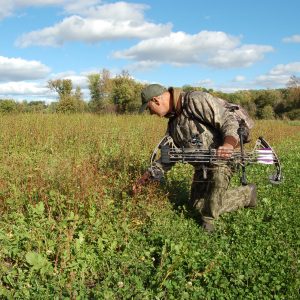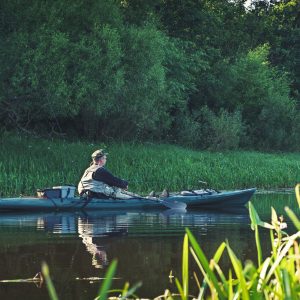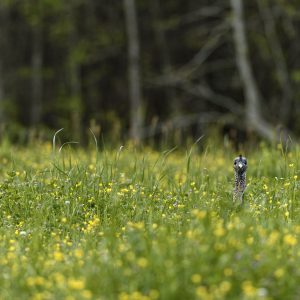Dove hunting can mean a great deal of things to those who have spent time in a prepared field over the years in pursuit of this small, grey bird. Retrieving dogs are in play, perhaps football updates on your smart phone, and some of the best opportunities of the year to give a shout out to someone who made a good shot. Making these scenarios come to life and creating a reliable dove field requires a commitment of time, money and land management knowledge – to first attract doves to your field and then have them imprint so they keep making annual return visits.
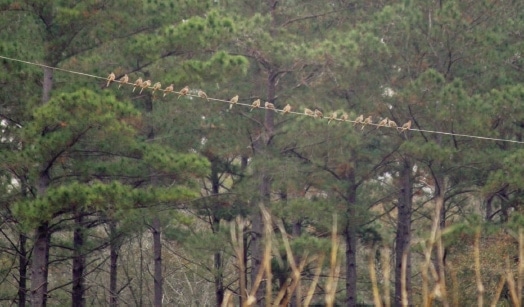
What makes a dove field draw doves like a magnet? Certainly location has a great deal to do with it, a generous food source is also necessary, but sometimes it takes smaller land management tweaks along the way to improve your dove field. Over time experienced land managers recognize when the field needs some disking, mowing or burning in order to tune it up. Then it takes follow-up scouting with “boots on the ground” after each field manipulation to better understand what is effective for your field.
Larger fields of 15 acres or more, in agricultural production areas that produce peanuts, wheat or corn likely already attract doves, and the task is simply how to congregate them into a small enough area to hunt. These larger types of areas are more likely to yield multiple hunts over the course of the hunting season and can usually accommodate more hunters. Contacts with these farming operations are cultivated over time by discerning dove hunters.
Smaller fields of 5 acres or less have a limited amount of food to offer, but they can also be hotspots that yield one or two very good hunts each fall. An area as small as 3 acres, perhaps along a power line right-of-way could be an option for small acreage landowners who would like to try and attract some doves, but this smaller zone might only support one or two guns during a hunt. The point is that if you want to try and attract doves then let your conscience be your guide.
Like so many other habitat management objectives, a dove field needs a commitment of multiple years in order to derive consistent success. A well-managed dove field can provide benefits to all wildlife, before, during and after the hunting season. When you begin to notice numerous species of wildlife utilizing your dove field all year long, that’s the true reward for all your efforts.
Growing up a Dove Hunter
Thanks to a father with an affinity for wingshooting, when I was a youth I was carried along to visit a variety of dove fields across the Lowcountry of South Carolina. I recall him borrowing a single-shot 20-gauge for me to use, but of course I wanted to move up to a 12-gauge just as soon as possible. Most of those hunts included harvested corn fields, piney woods, cold weather and lots and lots of doves.
Over time we had the opportunity to hunt large fields with enough folks for a traditional barbecue lunch included, and on the other hand we hunted smaller fields that produced more intimate hunts. The bigger hunts were social productions that were planned out well in advance, while the smaller hunts were invitations more of opportunity where spotters saw increased dove activity and called for a hunt to take advantage of it.
My chief observation taken away from the dove fields all those years ago is the doves seemed to bunch-up more back then. Therefore I see the challenge today is how to attract and hold a migratory game birds that may fly in or out of your county on the winds associated with the next weather front. Accepting that challenge is a hardship for some gamekeepers, but not for me since I was instilled with a deeply-rooted bond to dove hunting.
Today’s Dove Fields

If at all possible a great start to a making a reliable dove field includes an investment in infrastructure. Say what? Big game populations can be intrusive to your small game endeavors, and putting up a deer and hog proof wire fence around your dove field is a great way to protect sensitive crops like sunflower seeds that are planted specifically with mourning doves in mind.
Next up in your dove field infrastructure plans are a few creosote poles and fake power line wires for the doves to stage on before and after they feed. Do not underestimate the dramatic attraction strength that a power line can have on the potential for any dove field. It’s not a requirement by any means, but if your budget allows for it, contact someone with a backhoe and a truck with a lift bucket to help you install this proven dove magnet.
Most folks will plant a variety of grains which helps to keep the doves fed over the course of the season since different seeds mature at different times. Planting a dove field can also be an aesthetically pleasing endeavor with corn rows flanked by brown top millet running parallel to the longer side of a rectangular field and so on. There is nothing wrong with a good looking dove field and it may even send a signal to wildlife that agricultural practices are in use.
Corn can be planted in early summer and can exist as the longest lasting food source over the entire dove season. Brown top millet matures in 60 to 70 days, proso millet matures in 80 to 90 days and sunflowers mature in 90 to 100 days, so they can all be timed to peak a couple weeks before the hunting season opens, around here, usually around Labor Day. Remember, it is legal to harvest grain from a field and then hunt over it, or to mow the grain down and then hunt over it. Here in NC, baiting of doves is defined as when grain that was not grown onsite is brought into the dove field.
Too Soon To Dove Hunt
In my experience, establishing a dove field is a process that takes time, and grandiose plans to begin hosting dove hunts just aren’t prudent until you develop consistency. The introduction of hunting pressure too soon is one of the worst things you can do if trying to attract doves. Patient stewardship is often required to build a hunting spot.
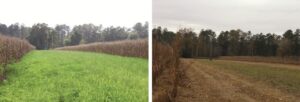
Before and after preparing for the hunt
Keep a small but regular list of family or friends on stand-by for when a few hundred doves do visit your field. If dove numbers are too few to call for a hunt, then hold your fire completely. Now here’s the tough part, if you don’t attract enough doves to hunt all year, then you still have to be at peace with the decision not to hunt. Harder still, it may take a few years to begin attracting doves to a point when you should hunt them.
For some it simply won’t add up – to pay for the planting of the crop, and the tractor time if an immediate dividend in the form of dove hunting does not materialize.
Did I mention that doves prefer a field that is free of weeds? They like to forage on bare dirt, so factor in some herbicide costs too. Commitment comes in many forms when your management project involves anything migratory.
Since congregating the doves is the challenge, it may take multiple seasons to get doves using your field. The hope is that they imprint on the site and learn each year to return – that will bring other doves to enjoy your offerings. Not unlike other game animals, doves will seek out and utilize the best habitat they encounter, a part of nature’s survival of the fittest mantra.
The Social Aspect
Hunting mourning doves is one of the most popular hunt activities in the country, making fall dove shoots a social tradition. If you are involved with an established dove hunting clan or club then consider yourself fortunate. Naturally, if there are less congregations of doves, then there may also be fewer opportunities for dove hunters.
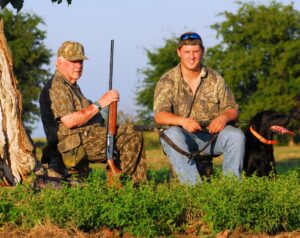 My own dove field aspirations began with the singular purpose to provide a dove hunt for family members each season, and that goal has been accomplished. The number of doves harvested has been well below any legal limit, but newbie hunters had an opportunity to look forward to, and non-hunting family members were exposed to the positive aspects of a dove hunt.
My own dove field aspirations began with the singular purpose to provide a dove hunt for family members each season, and that goal has been accomplished. The number of doves harvested has been well below any legal limit, but newbie hunters had an opportunity to look forward to, and non-hunting family members were exposed to the positive aspects of a dove hunt.
A little further down the dove field establishment timeline I was able to invite a few friends to a hunt, and one father asked to bring his son to sit alongside him. I had scouted the field and doves were plentiful, but on this day they flew erratic and high and the hunt host was not satisfied without hearing a lot shotgun reports, but that’s hunting.
A chance encounter with the youth a few months later brought an unexpected footnote to that hunt. He briefly outlined that he really enjoyed the hunt, and that he thought the dove field looked great and enjoyed seeing all the doves flying by. He reminded me that the bigger picture of honoring the tradition of dove hunting was in place that day, and that no one hunt defines a dove field, that process takes years.

